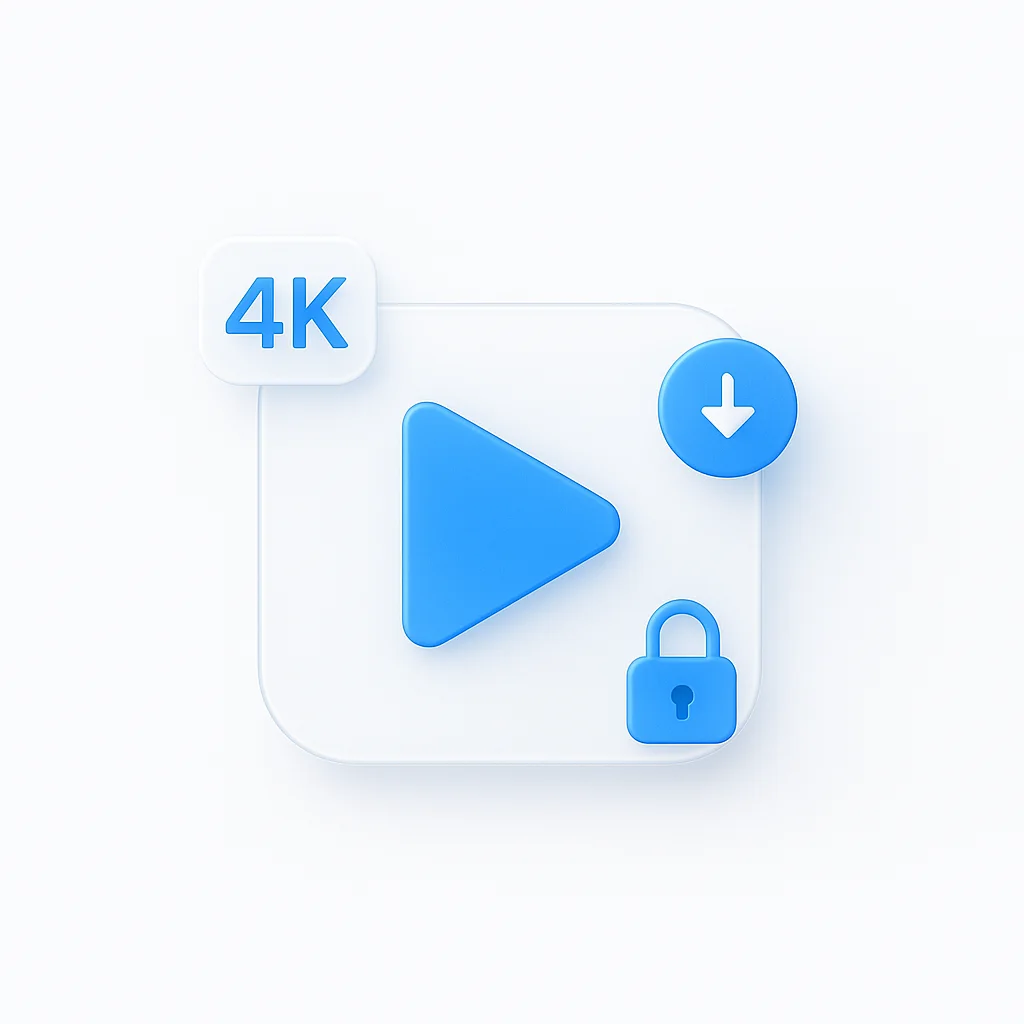Vorbei sind die Zeiten langweiliger, textlastiger Folien, die Ihr Publikum einschläfern. KI revolutioniert die Welt der Präsentationen und macht sie dynamischer, fesselnder und einfacher zu erstellen als je zuvor. Vom Brainstorming von Ideen und der Erstellung atemberaubender Grafiken über das Zusammenfassen bestehender Videos bis hin zur Erstellung von KI-gestützten Referenten verändern diese hochmodernen Tools das Spiel. Machen Sie sich bereit, die besten KI-Präsentationstools zu erkunden und zu entdecken, wie sie Ihre Kommunikationsfähigkeiten verändern können.
Einführung
Präsentationen befinden sich inmitten einer großen Transformation, und Video ist führend. Vorbei sind die Zeiten statischer Folien und monotoner Vorträge. In der heutigen Welt geht es darum, Aufmerksamkeit zu erregen und das Publikum zu fesseln. Hier kommt KI ins Spiel.
Künstliche Intelligenz revolutioniert die Art und Weise, wie wir Präsentationen erstellen, und macht sie dynamischer, überzeugender und wirkungsvoller als je zuvor. Vom Brainstorming von Ideen und der Erstellung atemberaubender Grafiken bis hin zur kompletten Videobearbeitung nehmen KI-gestützte Tools die schwere Arbeit ab, sodass Sie sich auf die Kernbotschaft konzentrieren können, die Sie vermitteln möchten.
Top-Tools auf einen Blick
| Toolname | Überblick | Vorteile | Nachteile | Am besten geeignet für | Bewertung |
|---|---|---|---|---|---|
| ScreenApp Video Summarizer | Optimiert die Erstellung von Präsentationen durch die Verdichtung von Videoinhalten. | Zeitsparend, KI-gestützte Identifizierung von Schlüsselpunkten, anpassbar. | Abhängig von der Quellqualität, eingeschränkte kreative Kontrolle. | Vertriebsteams, Pädagogen, Inhaltsersteller. | ★★★★☆ |
| Synthesia | Generiert Videopräsentationen mit KI-Referenten. | Einfach zu bedienen, Auswahl des Referenten, Anpassung, mehrsprachige Unterstützung. | Potenzial für “Uncanny Valley”, eingeschränkte Kontrolle über Nuancen. | Schulungsmodule, Erklärvideos, globale Präsentationen. | ★★★★ |
| Repurpose.io | Wandelt lange Videos in mundgerechte, Social Media-taugliche Präsentationen um. | Wiederverwendung von Inhalten, Workflow-Automatisierung, Vorlagen und Anpassung. | Eingeschränkte Präsentationserstellung, Fokus auf Online-Plattformen, eingeschränkte kostenlose Funktionen. | Inhaltsersteller, Vermarkter, Personen, die die Verteilung automatisieren möchten. | ★★★☆ |
| Descript | All-in-One-Video-/Audio-Editor mit KI-Funktionen. | Einzigartige Bearbeitung, integrierte Bildschirmaufzeichnung, automatische Transkription, Studio-Sound, Multimedia-Unterstützung. | Lernkurve, eingeschränkte Anpassungsmöglichkeiten, Preisgestaltung. | Erstellung von Videopräsentationen, Bearbeitung und Optimierung aufgezeichneter Präsentationen. | ★★★★ |
| Visme | Vielseitige Designplattform mit umfangreichen Möglichkeiten zur Erstellung von Präsentationen. | Benutzerfreundliche Oberfläche, vielfältige Vorlagen, interaktive Elemente, Datenvisualisierungstools, kostenloser Plan verfügbar. | Eingeschränkte Funktionen des kostenlosen Plans, steilere Lernkurve für fortgeschrittene Funktionen, weniger Anpassungsoptionen, Preisgestaltung kann teuer sein. | Erstellung professionell aussehender Präsentationen, Lehrer, Pädagogen, Studenten, kleine Unternehmen, Startups. | ★★★★ |
| Designs.ai | Bietet Tools speziell für Videopräsentationen. | KI-gestützte Designunterstützung, große Auswahl an Vorlagen, kostenlose Stufe verfügbar. | Eingeschränkte Designanpassung, Lernkurve für KI-Funktionen, eingeschränkte Offline-Funktionalität. | Erstellung professionell aussehender Präsentationen, Benutzer, die neu in der Präsentationsgestaltung sind, Nicht-Designer oder kleine Unternehmen. | ★★★☆ |
| Tome | Storytelling-fokussiertes Präsentationstool. | KI-gestützte Inhaltserstellung, einzigartige und moderne Vorlagen, Cloud-basiert und kollaborativ. | Eingeschränkte Anpassungsoptionen, Preisgestaltung, neueres Tool. | Einzelpersonen oder Teams, Benutzer, die eine saubere und moderne Ästhetik bevorzugen, Referenten, die Wert auf Cloud-basierten Zugriff und Echtzeit-Zusammenarbeit legen. | ★★★☆ |
| Beautiful.ai | Betont Designqualität und Konsistenz. | KI-gestütztes Design, umfangreiche Vorlagenbibliothek, Cloud-basierte Zusammenarbeit, einfache Freigabe, umfangreiche Medienbibliothek. | Eingeschränkte Offline-Funktionalität, weniger Anpassungsoptionen, Preisstruktur. | Nicht-Designer, Teams, schnelle Präsentationen. | ★★★★ |
| Lumen5 | Wandelt vorhandene Inhalte in ansprechende Videopräsentationen um. | Einfache Bedienung, ansprechende Grafiken, Textzusammenfassung. | Eingeschränkte Designflexibilität, Video-zentriert, eingeschränkte Textoptionen. | Kurze, informative Präsentationen, Social Media-Inhalte, Nicht-Designer. | ★★★☆ |
| Prequel | Bietet KI-gestützte Vorlagen und Effekte für kurze Videopräsentationen. | Fokus auf Storytelling, ansprechendes Design, einfache Bedienung, Cloud-basiert. | Eingeschränkte Funktionen, Preis, Lernkurve. | Einzelpersonen oder kleine Teams, Referenten, die auffallen möchten, zwanglose Präsentationen. | ★★★☆ |
Top 10 KI-Tools
1. ScreenApp Video Summarizer
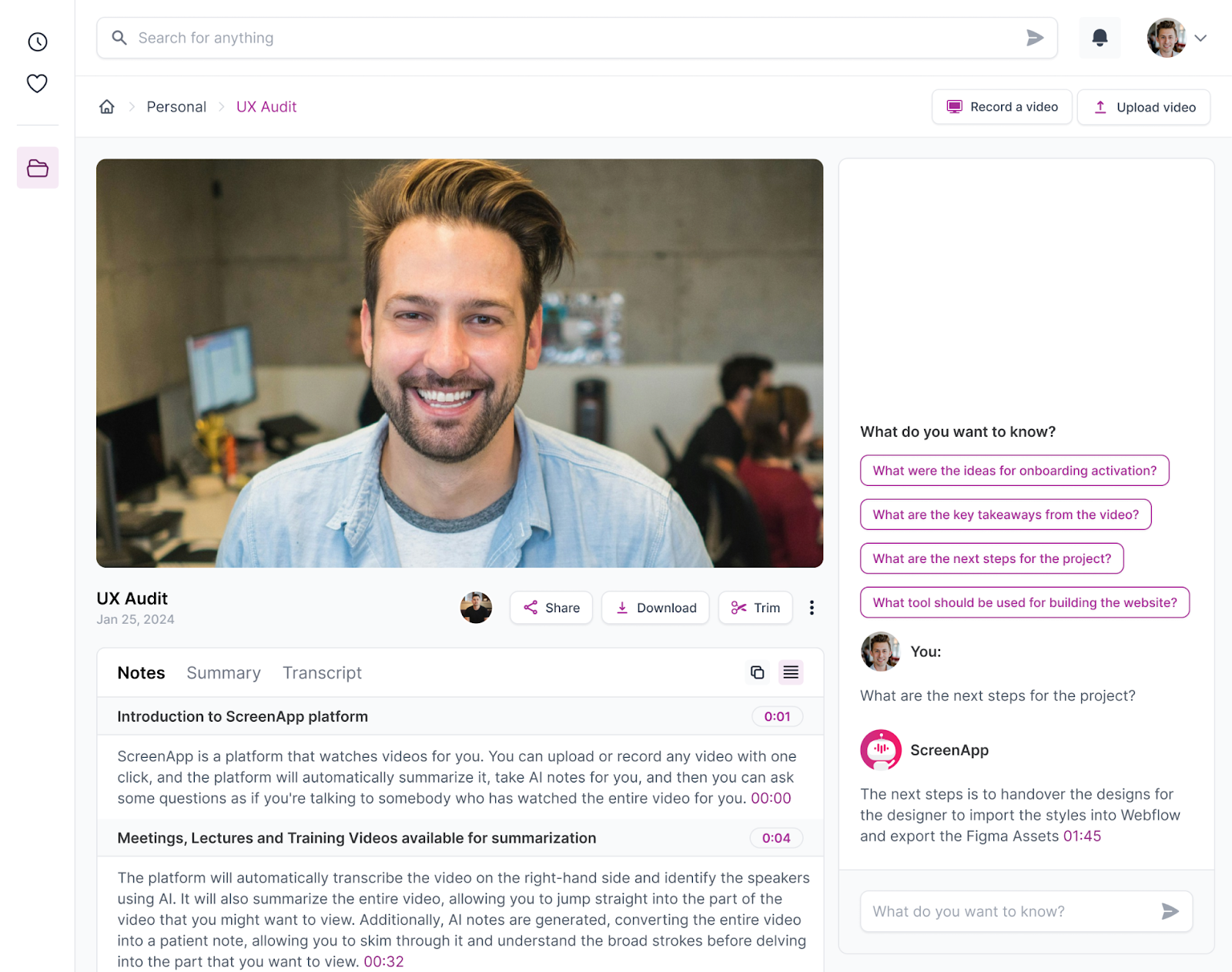
Der Video Summarizer von ScreenApp zeichnet sich durch die Optimierung des Präsentationserstellungsprozesses aus, indem er vorhandene Videoinhalte intelligent zusammenfasst. Er ist eine fantastische Möglichkeit, Aufzeichnungen, die Sie bereits haben, für fokussiertere, wirkungsvollere Präsentationen zu nutzen.
Vorteile:
Zeitsparend: Reduziert die Zeit, die für das manuelle Überprüfen und Bearbeiten von Videos aufgewendet wird, drastisch.
Identifizierung von Schlüsselpunkten: KI erkennt genau die wichtigsten Abschnitte Ihres Videomaterials.
Anpassbar: Kontrolle über die Zusammenfassungslänge und den gewünschten Präsentationsstil.
Nachteile:
Abhängigkeit von der Quellqualität: Die Qualität der Zusammenfassung ist an die Klarheit und Struktur des Originalvideos gebunden.
Eingeschränkte kreative Kontrolle: Am besten geeignet für die Wiederverwendung, nicht für die Erstellung von Präsentationen von Grund auf.
Am besten geeignet für:
Vertriebsteams, die Produktdemos oder Erklärvideos wiederverwenden.
Pädagogen, die wichtige Lektionen aus Vorlesungen extrahieren.
Inhaltsersteller, die lange Videos in Zusammenfassungen im Präsentationsstil umwandeln.
Bewertung: 4,5/5
Persönliche Empfehlung: Wenn Sie häufig mit vorhandenen Videoinhalten arbeiten und diese in Präsentationen umwandeln müssen, ist der Video Summarizer von ScreenApp ein absoluter Game-Changer. Seine Fähigkeit, die Kernbotschaft eines Videos zu identifizieren und herauszufiltern, ist überraschend genau und spart Ihnen wertvolle Zeit und Mühe.
2. Synthesia
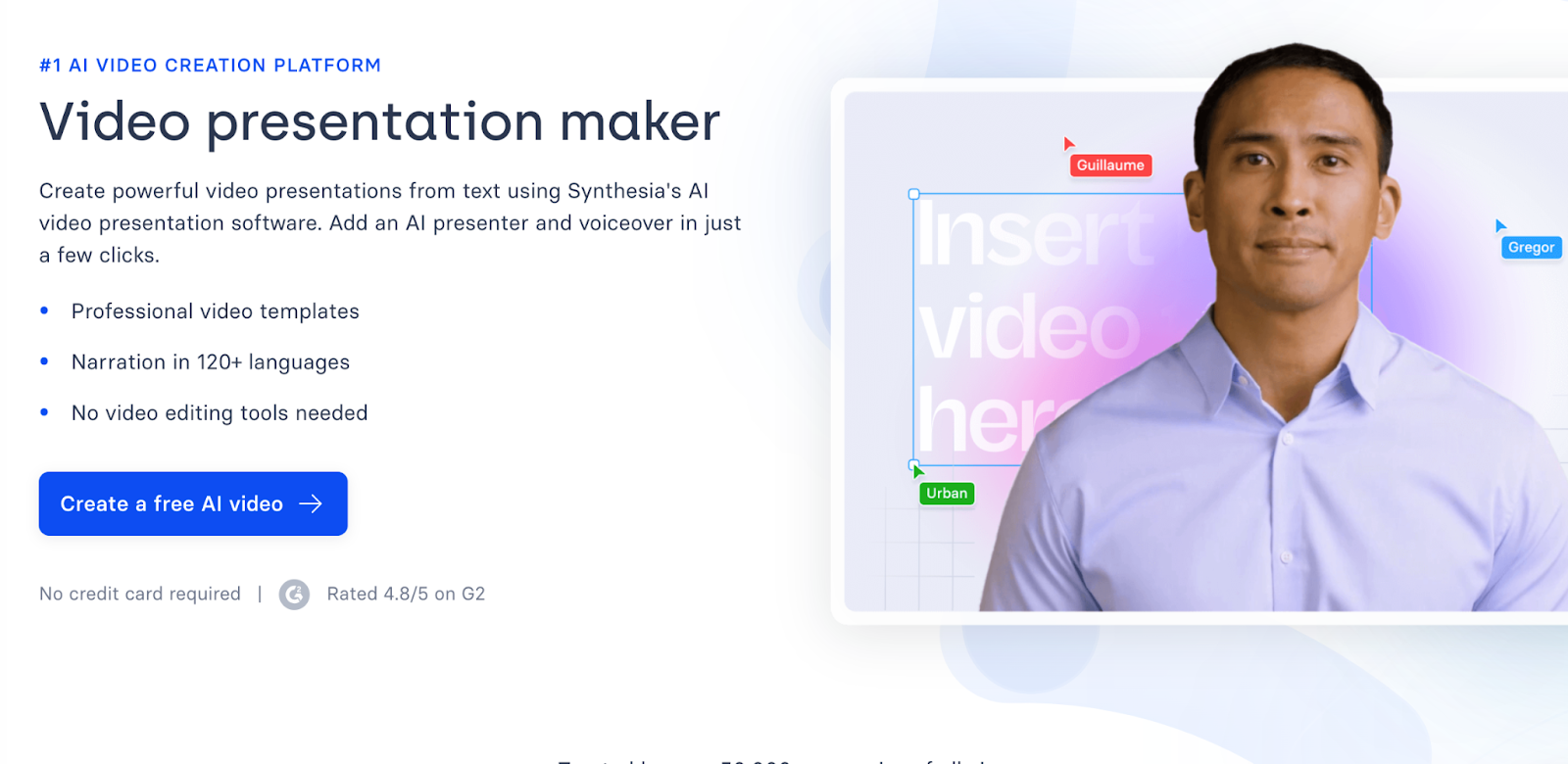
Mit Synthesia können Sie Videopräsentationen mit realistischen KI-Referenten erstellen, indem Sie einfach Text eingeben. Es betont die Anpassung für ein personalisiertes Präsentationserlebnis.
Vorteile:
Einfache Bedienung: Keine Videoaufnahmen oder komplexen Bearbeitungskenntnisse erforderlich.
Auswahl des Referenten: Eine große Auswahl an verschiedenen KI-Referenten, die zu Ihrer Marke und Botschaft passen.
Anpassung: Steuern Sie virtuelle Hintergründe, fügen Sie Bilder hinzu und integrieren Sie Textüberlagerungen.
Mehrsprachige Unterstützung: Generieren Sie Präsentationen in zahlreichen Sprachen mithilfe der Text-to-Speech-Funktion.
Nachteile:
Potenzial für “Uncanny Valley”: Einige Zuschauer empfinden KI-Referenten möglicherweise als leicht unnatürlich, abhängig vom Grad des Realismus.
Eingeschränkte Kontrolle über Nuancen: Das Feintuning von Vortrag und Tempo kann im Vergleich zu einem echten Referenten eine Herausforderung sein.
Am besten geeignet für:
Schulungs- und E-Learning-Module, bei denen eine konsistente Vermittlung unerlässlich ist.
Erstellung personalisierter Erklärvideos und interner Kommunikation.
Generieren von Präsentationen in mehreren Sprachen für ein globales Publikum.
Bewertung: 4/5
Persönliche Empfehlung: Synthesia ist ein leistungsstarkes Tool, wenn ein Videoreferent gewünscht wird, aber Zeit und Ressourcen für Dreharbeiten eine Einschränkung darstellen. Das Experimentieren mit Formulierungen und Vortragsstilen kann die Einschränkungen mildern und ansprechende Ergebnisse erzielen.
3. Repurpose.io
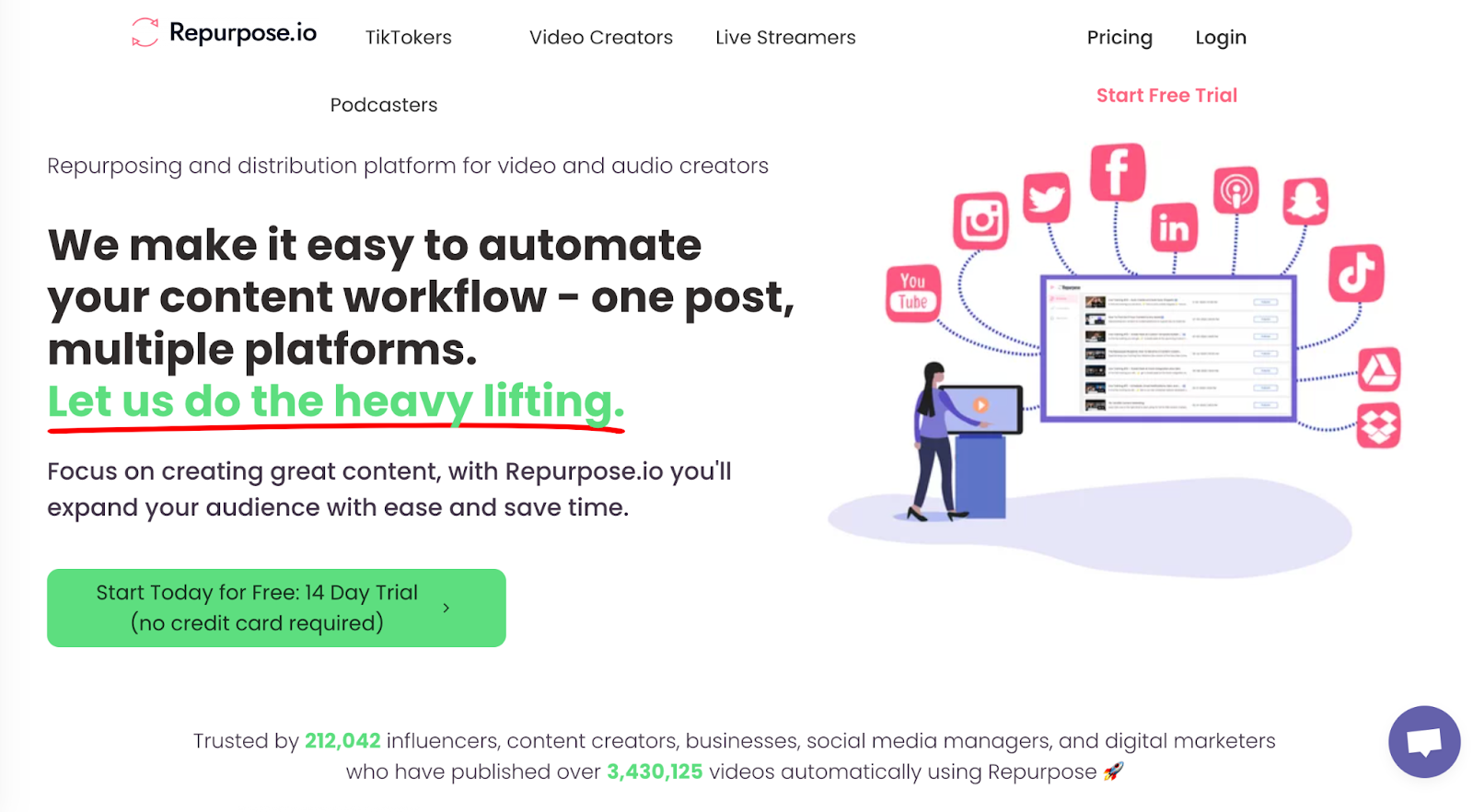
Automatisieren Sie die Umwandlung von langen Videos (Webinaren, Podcasts) in mundgerechte, Social Media-taugliche Präsentationen mit Schlüsselpunkten.
Vorteile:
Wiederverwendung von Inhalten: Repurpose.io zeichnet sich durch die Wiederverwendung vorhandener Inhalte wie Videos und Podcasts in verschiedenen Präsentationsformaten wie Social Media-Posts, Blogartikeln und E-Mail-Newslettern aus. Dies spart Zeit und Mühe bei der Inhaltserstellung.
Workflow-Automatisierung: Erstellen und automatisieren Sie Workflows, um Ihre Präsentationsinhalte auf mehreren Plattformen zu verteilen, wodurch Sie Zeit sparen und eine konsistente Botschaft über alle Kanäle hinweg gewährleisten.
Vorlagen und Anpassung: Verwenden Sie vorgefertigte Vorlagen für verschiedene Plattformen und passen Sie diese mit Ihrem Branding und Stil an.
Nachteile:
Eingeschränkte Präsentationserstellung: Repurpose.io ist kein vollwertiges Tool zur Präsentationserstellung. Es zeichnet sich durch die Wiederverwendung vorhandener Inhalte aus, nicht durch die Erstellung von Präsentationen von Grund auf.
Fokus auf Online-Plattformen: Der Hauptfokus liegt auf der Wiederverwendung für Online-Plattformen wie Social Media, E-Mail und Blogs. Es ist möglicherweise nicht ideal für die Erstellung traditioneller Folienpräsentationen.
Eingeschränkte kostenlose Funktionen: Obwohl es einen kostenlosen Plan bietet, gibt es Einschränkungen hinsichtlich der Anzahl der Inhaltselemente, die Sie wiederverwenden können.
Am besten geeignet für:
Inhaltsersteller und Vermarkter, die vorhandene Video- und Audioinhalte in verschiedenen Formaten für Social Media-, E-Mail- und Blog-Marketing wiederverwenden möchten.
Personen, die die Verteilung von Präsentationsinhalten über mehrere Online-Plattformen hinweg automatisieren möchten.
Bewertung: 3,5/5
Persönliche Empfehlung:
Repurpose.io ist ein wertvolles Tool für Inhaltsersteller und Vermarkter, die vorhandene Inhalte für Multi-Plattform-Marketing nutzen möchten. Es ist jedoch kein Ersatz für eine dedizierte Präsentationserstellungssoftware, wenn Ihr Hauptbedarf darin besteht, Präsentationen von Grund auf zu erstellen. Berücksichtigen Sie Ihre spezifischen Bedürfnisse, bevor Sie entscheiden, ob Repurpose.io das richtige Tool für Ihren Präsentationsworkflow ist.
4. Descript
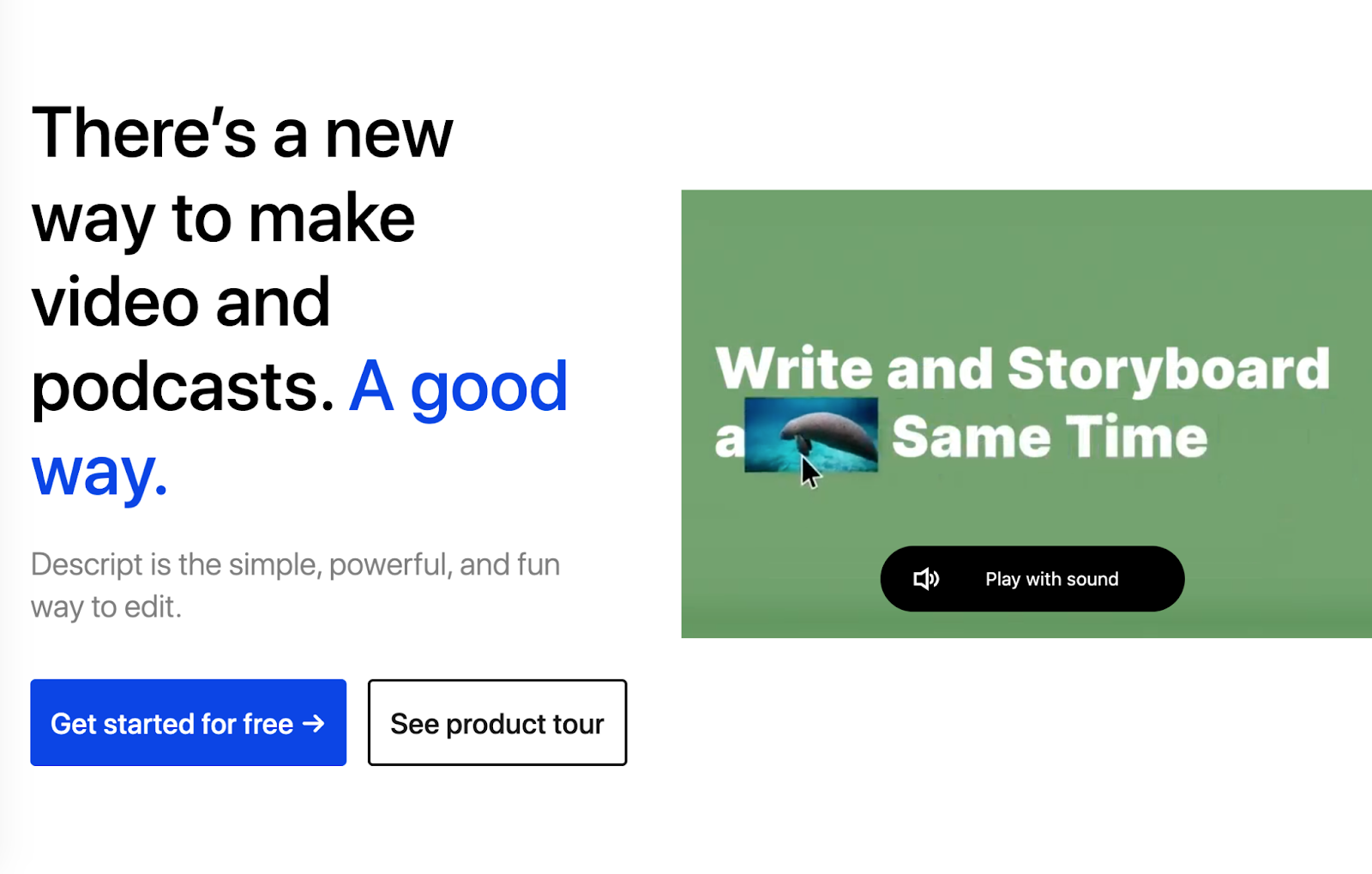
Leistungsstarker All-in-One-Video-/Audio-Editor mit KI-Funktionen wie transkriptbasierter Bearbeitung, Entfernung von Hintergrundgeräuschen und sogar einem Tool zum Entfernen von Füllwörtern.
Vorteile:
Einzigartige Bearbeitung: Bearbeiten Sie Ihre Videos, indem Sie das Transkript bearbeiten, sodass Sie Füllwörter, Stolpersteine einfach entfernen und bestimmte Abschnitte neu aufnehmen können.
Integrierte Bildschirmaufzeichnung: Erfassen Sie Ihren Bildschirm und Ihre Präsentationen direkt in Descript.
Automatische Transkription: Sparen Sie Zeit mit einer genauen automatischen Transkription Ihrer Aufnahmen.
Studio Sound: Verbessern Sie Ihre Audioqualität mit Hintergrundgeräuschentfernung und anderen Anpassungen.
Multimedia-Unterstützung: Kombinieren Sie Folien, Bilder, Videos und Audio in einem einzigen Projekt.
Nachteile:
Lernkurve: Die Oberfläche kann im Vergleich zu einfachen Präsentationstools etwas komplex sein.
Eingeschränkte Anpassungsmöglichkeiten: Vorlagen und Designoptionen sind nicht so umfangreich wie bei spezieller Präsentationssoftware.
Preisgestaltung: Die kostenlose Stufe ist eingeschränkt, und kostenpflichtige Pläne können für die gelegentliche Nutzung teuer sein.
Am besten geeignet für:
Erstellung von Videopräsentationen aus vorhandenen Folien oder Skripten.
Bearbeiten und Optimieren aufgezeichneter Präsentationen.
Einzelne Ersteller, die sich auf ansprechende und ausgefeilte Präsentationen konzentrieren.
Bewertung: 4/5
Persönliche Empfehlung:
Descript ist ein leistungsstarkes Tool zum Erstellen und Bearbeiten von Videopräsentationen, das einzigartige Funktionen und einen optimierten Workflow bietet. Es kann jedoch eine steilere Lernkurve aufweisen und die umfangreichen Designanpassungsmöglichkeiten spezieller Präsentationssoftware vermissen lassen. Berücksichtigen Sie Ihre Bedürfnisse und Ihr Budget, bevor Sie sich entscheiden.
Wenn Sie Wert auf Bearbeitungsflexibilität und einen einzigartigen Workflow für Videopräsentationen legen, ist Descript eine gute Wahl. Wenn Sie hochgradig anpassbare Folien und eine einfachere Oberfläche benötigen, sind herkömmliche Präsentationstools möglicherweise besser geeignet.
5. Visme
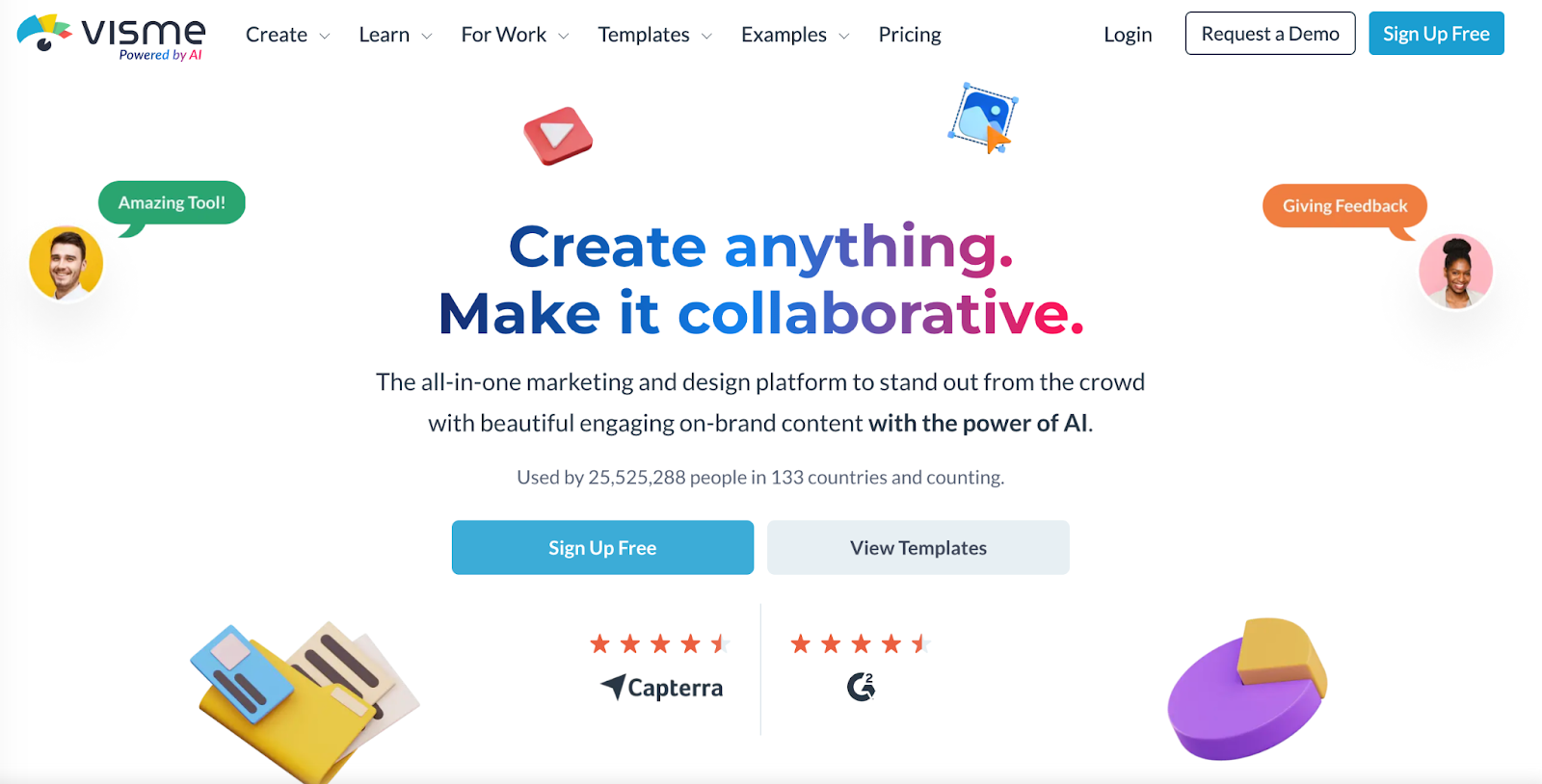
Vielseitige Designplattform mit umfangreichen Möglichkeiten zur Erstellung von Präsentationen. KI hilft bei der Auswahl von Layouts, Grafiken und kann sogar ganze Folien basierend auf Text generieren.
Vorteile:
Benutzerfreundliche Oberfläche: Einfach zu erlernen und zu verwenden, auch für Anfänger.
Große Vielfalt an Vorlagen und Themen: Spart Zeit und sorgt für ein professionelles Aussehen.
Interaktive Elemente: Macht Präsentationen ansprechender und einprägsamer.
Datenvisualisierungstools: Hilft, Daten in klare und verständliche Grafiken umzuwandeln.
Kostenloser Plan verfügbar: Ideal für Gelegenheitsnutzer oder die Erstellung einiger weniger Präsentationen.
Nachteile:
Eingeschränkte Funktionen des kostenlosen Plans: Wasserzeichen, eingeschränkter Speicherplatz und Exporte.
Steilere Lernkurve für fortgeschrittene Funktionen: Animationen, Interaktivität usw.
Weniger Anpassungsoptionen im Vergleich zu einigen Wettbewerbern: Möglicherweise nicht ideal für sehr spezifische Designanforderungen.
Die Preisgestaltung kann für größere Teams oder häufige Nutzung teuer sein: Erfordert sorgfältige Überlegung.
Am besten geeignet für:
Erstellung professionell aussehender Präsentationen schnell und einfach.
Lehrer, Pädagogen und Studenten.
Kleine Unternehmen und Startups.
Erstellung von Präsentationen mit interaktiven Elementen.
Bewertung: 4/5
Persönliche Empfehlung:
Visme ist eine großartige Option für alle, die professionell aussehende Präsentationen ohne großen Aufwand erstellen möchten. Die benutzerfreundliche Oberfläche, die große Vielfalt an Vorlagen und der kostenlose Plan machen es zu einer guten Wahl für Anfänger. Wenn Sie jedoch viele Anpassungsoptionen benötigen oder ein knappes Budget haben, gibt es möglicherweise bessere Optionen.
6. Designs.ai
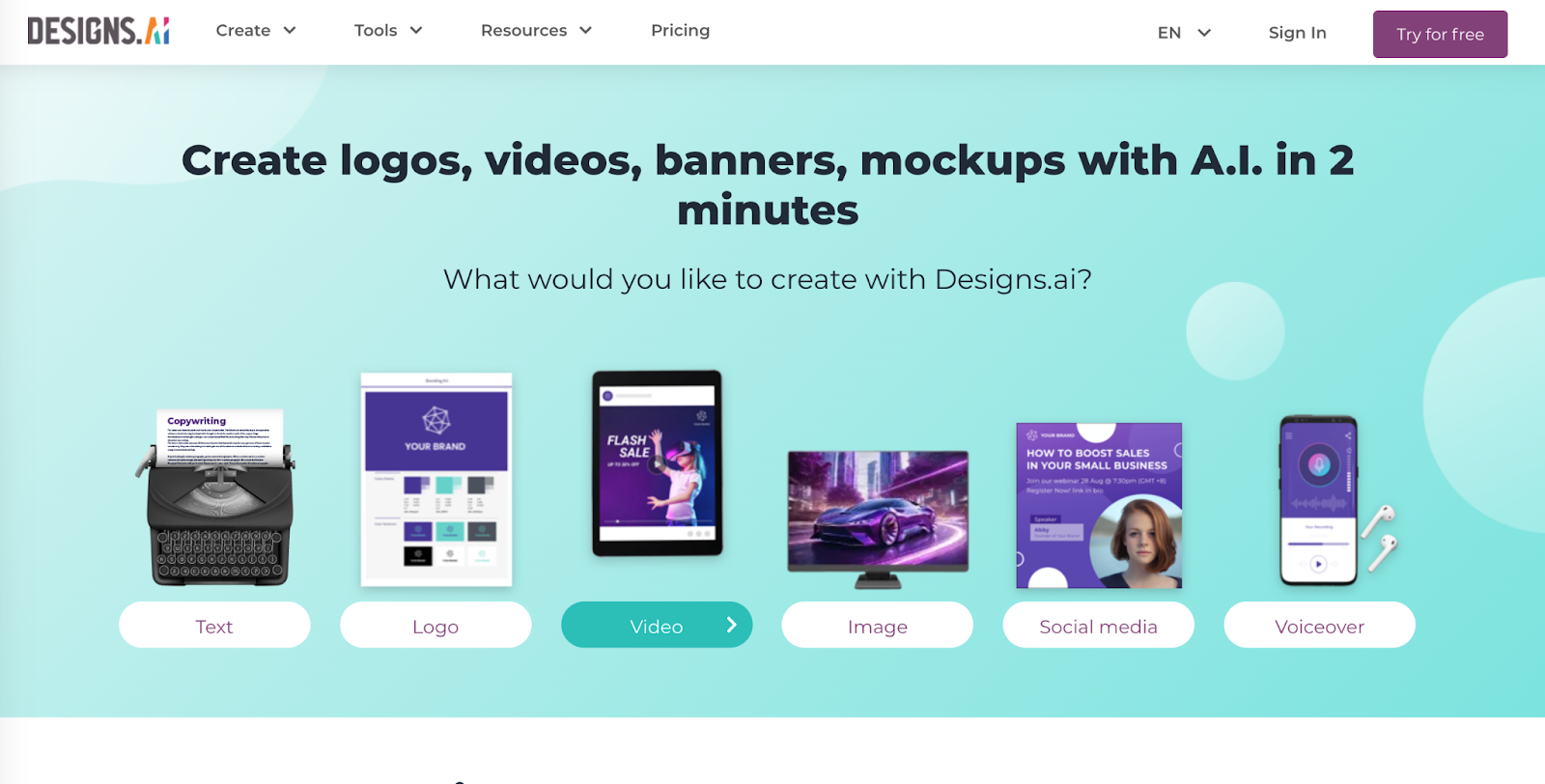
Bietet Tools speziell für Videopräsentationen, darunter Text-to-Video-Generierung, Stock-Footage-Bibliotheken und KI-gestützte Designunterstützung.
Vorteile:
KI-gestützte Designunterstützung: Designs.ai bietet Funktionen wie automatisch generierte Layouts, intelligente Größenänderung und Inhaltsvorschläge, um den Designprozess zu optimieren und Zeit zu sparen.
Große Auswahl an Vorlagen: Wählen Sie aus einer riesigen Bibliothek vorgefertigter Vorlagen für verschiedene Präsentationstypen, wodurch Sie sich die Arbeit ersparen, von Grund auf neu zu beginnen.
Kostenlose Stufe verfügbar: Im Gegensatz zu einigen Wettbewerbern bietet Designs.ai einen kostenlosen Plan mit grundlegenden Funktionen, der ihn für Gelegenheitsnutzer zugänglich macht.
Nachteile:
Eingeschränkte Designanpassung: Im Vergleich zu herkömmlichen Präsentationstools bietet Designs.ai möglicherweise weniger Flexibilität für hochgradig angepasste oder komplexe Präsentationen.
Lernkurve für KI-Funktionen: Während KI beim Design hilft, kann das Verständnis ihrer Fähigkeiten und Einschränkungen einige Erkundungen erfordern.
Eingeschränkte Offline-Funktionalität: Designs.ai ist in erster Linie webbasiert und bietet möglicherweise eingeschränkte Funktionen bei Offline-Nutzung.
Am besten geeignet für:
Erstellung professionell aussehender Präsentationen schnell und einfach.
Benutzer, die neu in der Präsentationsgestaltung sind und KI-Unterstützung wünschen.
Nicht-Designer oder kleine Unternehmen, die eine schnelle und kostengünstige Lösung benötigen.
Bewertung: 3,5/5
Persönliche Empfehlung:
Designs.ai ist eine gute Option für diejenigen, die ein benutzerfreundliches und KI-gestütztes Tool suchen, um schnell visuell ansprechende Präsentationen zu erstellen. Es ist jedoch möglicherweise nicht ideal für Benutzer, die umfangreiche Anpassungsmöglichkeiten oder Offline-Funktionalität benötigen. Wenn Designflexibilität und präzise Kontrolle Ihre obersten Prioritäten sind, ist die Erkundung traditioneller Präsentationssoftware wie Microsoft PowerPoint oder Google Slides möglicherweise besser.
Es wird empfohlen, sowohl Designs.ai als auch andere Optionen auszuprobieren, um zu sehen, welche am besten zu Ihren Bedürfnissen und Vorlieben passt.
7. Tome
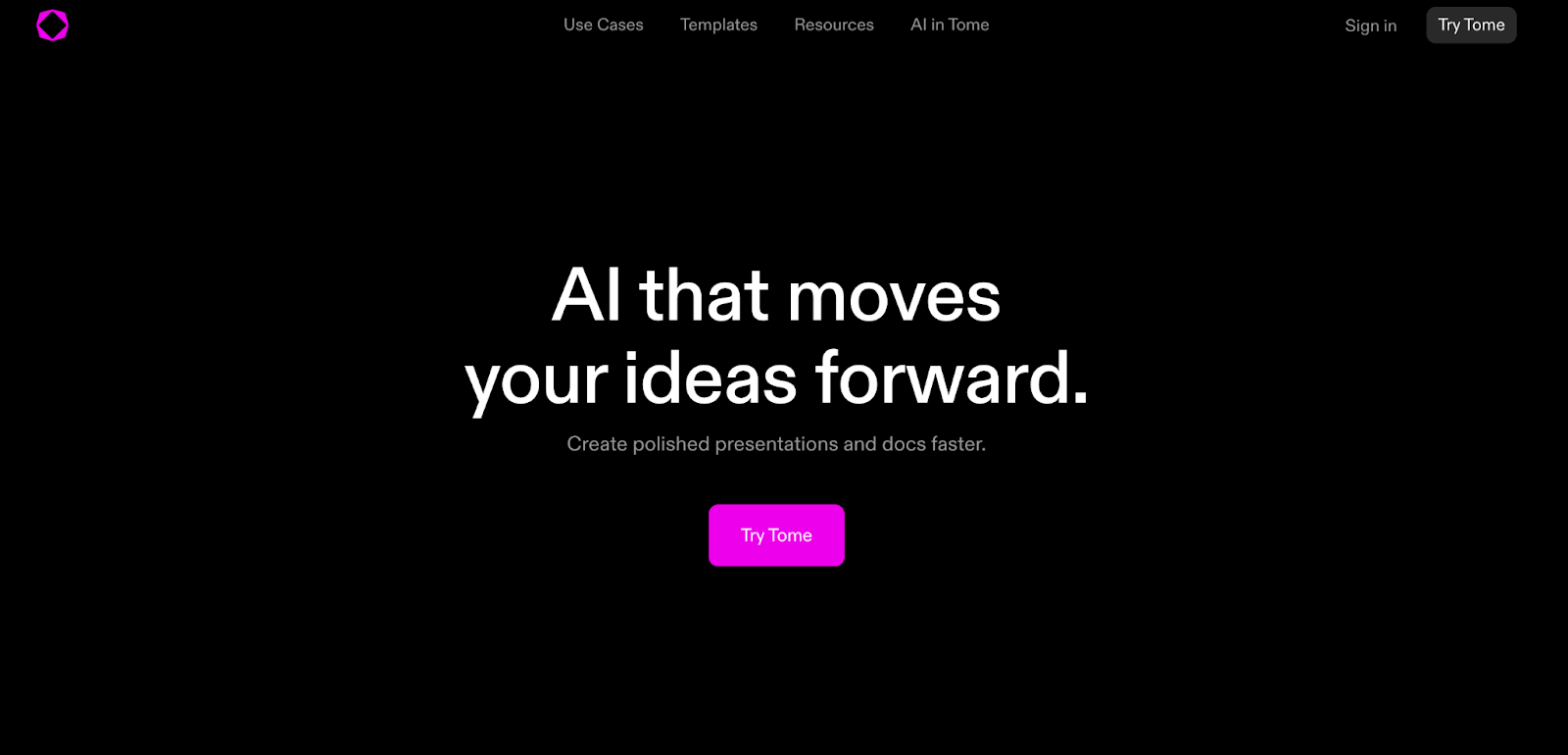
Storytelling-fokussiertes Präsentationstool. KI hilft bei der Generierung vollständiger Erzählungen und schöner Folienlayouts aus einer einfachen Gliederung.
Vorteile:
KI-gestützte Inhaltserstellung: Tome verwendet KI, um Text, Bilder und Videos basierend auf Ihrem Thema vorzuschlagen, wodurch Sie Präsentationen schneller und potenziell mit ansprechenderen Inhalten erstellen können.
Einzigartige und moderne Vorlagen: Tome bietet eine Vielzahl vorgefertigter Vorlagen mit Fokus auf moderne und minimalistische Ästhetik, die Ihren Präsentationen helfen können, sich abzuheben.
Cloud-basiert und kollaborativ: Sie können von jedem Gerät mit Internetzugang auf Ihre Präsentationen zugreifen und sie bearbeiten sowie in Echtzeit mit anderen zusammenarbeiten.
Nachteile:
Eingeschränkte Anpassungsoptionen: Obwohl Tome Vorlagen anbietet, ist der Grad der Anpassung für einzelne Elemente innerhalb von Folien im Vergleich zu herkömmlichen Präsentationstools möglicherweise geringer.
Preisgestaltung: Der kostenlose Plan von Tome hat eingeschränkte Funktionen, und kostenpflichtige Pläne können teurer sein als einige Wettbewerber.
Neueres Tool: Als relativ neues Tool verfügt Tome möglicherweise über weniger Integrationen und Funktionalitäten im Vergleich zu etablierter Präsentationssoftware.
Am besten geeignet für:
Einzelpersonen oder Teams, die mit Hilfe von KI schnell und einfach Präsentationen erstellen möchten.
Benutzer, die eine saubere und moderne Ästhetik für ihre Präsentationen bevorzugen.
Referenten, die Wert auf Cloud-basierten Zugriff und Echtzeit-Zusammenarbeit legen.
Bewertung: 3,5/5
Persönliche Empfehlung:
Tome kann ein wertvolles Tool für bestimmte Bedürfnisse sein, aber es ist wichtig, die Vor- und Nachteile abzuwägen. Wenn Sie Wert auf Geschwindigkeit, Benutzerfreundlichkeit und eine moderne Ästhetik legen und mit einem begrenzten Anpassungsbereich zufrieden sind, könnte Tome gut geeignet sein. Wenn Sie jedoch ein hohes Maß an Anpassung, erweiterte Funktionen benötigen oder die Preisgestaltung unattraktiv finden, sind andere Präsentationstools möglicherweise besser geeignet.
Es wird empfohlen, den kostenlosen Plan von Tome auszuprobieren oder alternative Tools wie Google Slides, Canva oder Microsoft PowerPoint zu erkunden, bevor Sie eine Entscheidung treffen.
8. Beautiful.ai
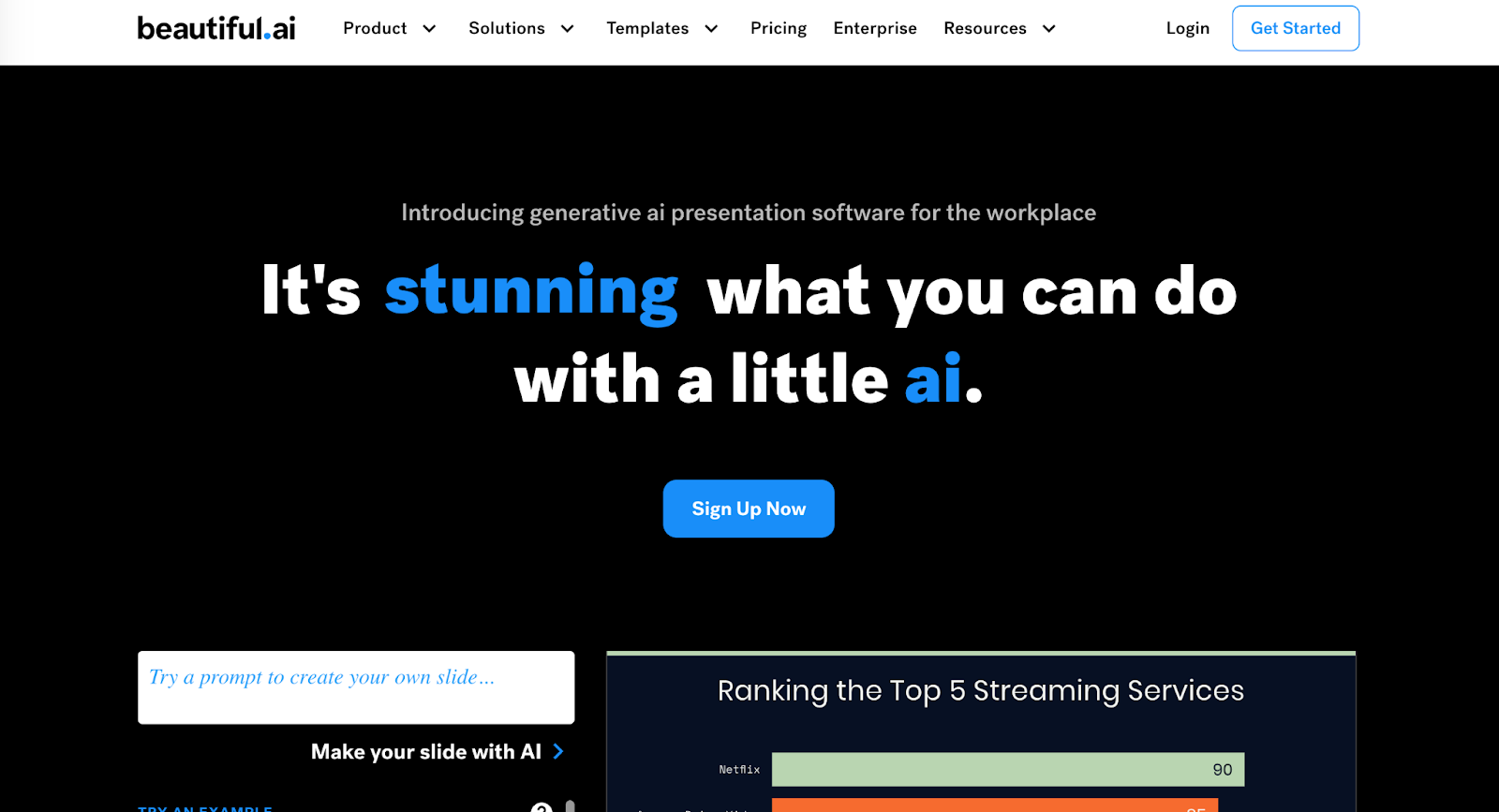
Betont Designqualität und Konsistenz. KI hilft bei Folienlayouts und schlägt Grafiken vor, die perfekt zu Ihren Inhalten passen.
Vorteile:
KI-gestütztes Design: Passt Layouts, Schriftarten und Farben automatisch für ein ausgefeiltes Aussehen an, auch mit minimalen Designkenntnissen.
Umfangreiche Vorlagenbibliothek: Bietet eine Vielzahl vorgefertigter Vorlagen für verschiedene Zwecke, wodurch Sie Zeit und Mühe sparen.
Cloud-basierte Zusammenarbeit: Ermöglicht die Bearbeitung und den Austausch von Feedback mit Teamkollegen in Echtzeit.
Einfache Freigabe: Teilen Sie Präsentationen per Link, betten Sie sie auf Websites ein oder exportieren Sie sie zur Offline-Nutzung.
Umfangreiche Medienbibliothek: Enthält Millionen von kostenlosen Fotos und Symbolen und unterstützt die Videointegration.
Nachteile:
Eingeschränkte Offline-Funktionalität: Bearbeitungsfunktionen sind hauptsächlich online verfügbar.
Weniger Anpassungsoptionen im Vergleich zu einigen Wettbewerbern: Bietet möglicherweise nicht das gleiche Maß an detaillierter Steuerung für sehr spezifische Designanforderungen.
Preisstruktur: Der kostenlose Plan hat eingeschränkte Funktionen, kostenpflichtige Pläne können für einzelne Benutzer teuer sein.
Am besten geeignet für:
Nicht-Designer: Benutzer, denen Designexpertise fehlt, aber professionell aussehende Präsentationen erstellen möchten.
Teams: Gemeinsame Präsentationen und einfache Freigabe zwischen Teammitgliedern.
Schnelle Präsentationen: Schnelle Erstellung von Präsentationen mit Hilfe vorgefertigter Vorlagen und KI-gestütztem Design.
Bewertung: 4/5
Persönliche Empfehlung:
Beautiful.ai ist eine gute Option für Einzelpersonen und Teams, die Wert auf Benutzerfreundlichkeit, Zusammenarbeit und professionelle Designästhetik legen. Benutzer mit fortgeschrittenen Designanforderungen oder diejenigen mit einem knappen Budget finden andere Präsentationstools möglicherweise besser geeignet. Es lohnt sich, den kostenlosen Plan auszuprobieren, um festzustellen, ob er Ihren Anforderungen entspricht, bevor Sie sich für ein kostenpflichtiges Abonnement entscheiden.
9. Lumen5
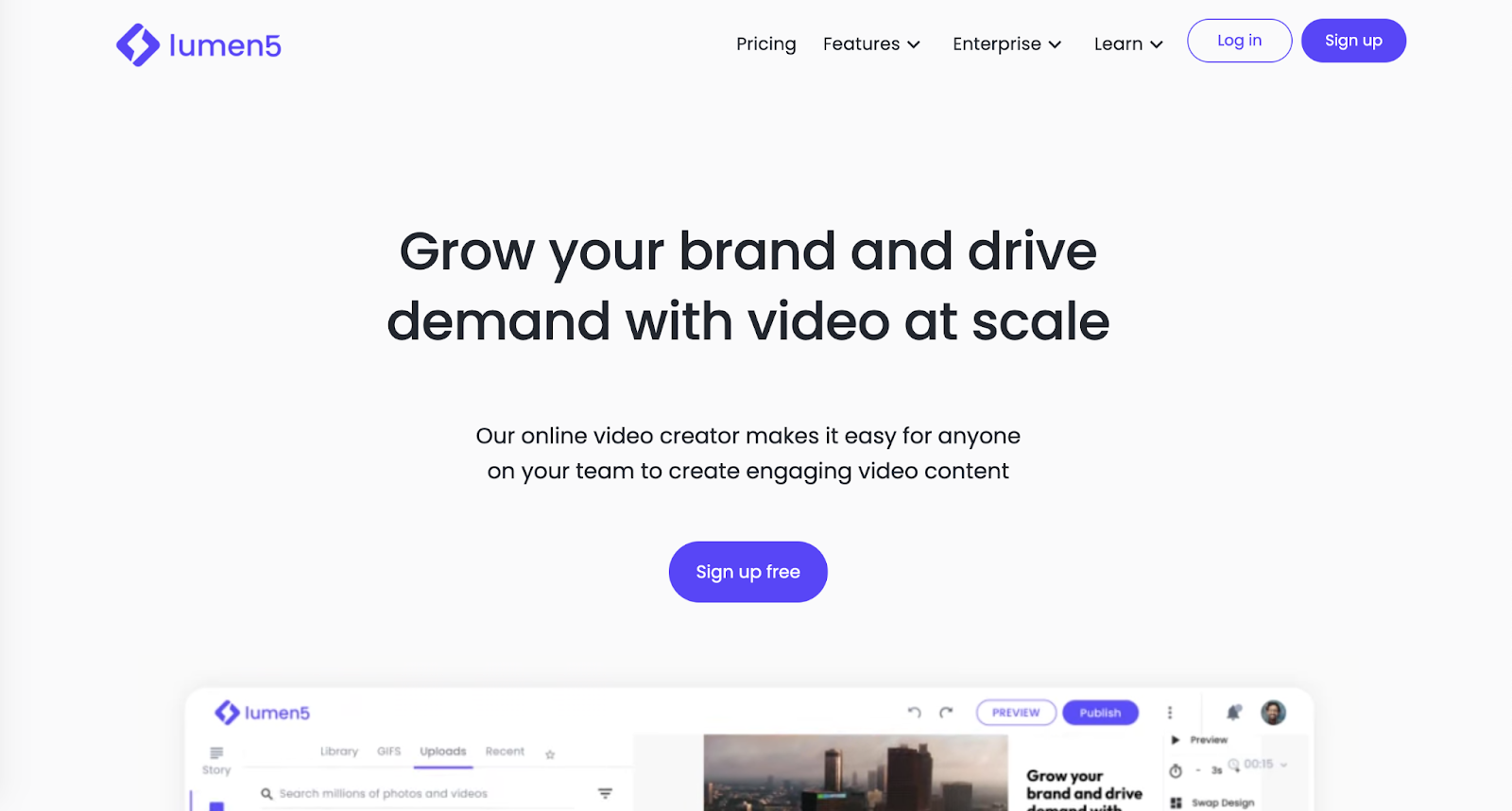
Spezialisiert sich auf die Umwandlung vorhandener Inhalte (wie Blogartikel) in ansprechende Videopräsentationen. Ideal für die Wiederverwendung.
Vorteile:
Einfache Bedienung: Die KI-gestützte Plattform von Lumen5 ermöglicht es jedem, schnell und einfach Videopräsentationen zu erstellen, auch ohne Designkenntnisse.
Ansprechende Grafiken: Die Plattform bietet Zugriff auf eine Bibliothek mit Stockvideos, Bildern und Musik, die die Erstellung visuell ansprechender Präsentationen ermöglicht.
Textzusammenfassung: Lumen5 kann vorhandene Textinhalte automatisch zusammenfassen, was Zeit und Mühe spart.
Nachteile:
Eingeschränkte Design


